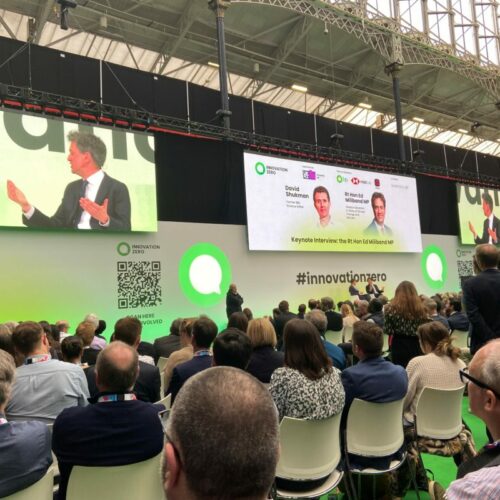Since it was unveiled in April 2021, Octopus Hydrogen has announced a number of major projects, marking itself as a key player in the emerging green hydrogen sector in the UK.
Most recently, this includes a project with Octopus Renewables – another arm of the wider Octopus Group – and the MIRA Technology Park for the development of a hydrogen and electric vehicle charging forecourt. In October, it announced a strategic partnership with Innova Renewables and Novus to roll out green hydrogen production across the country.
Current± caught up with Octopus Hydrogen’s founder and CEO William Rowe recently, to talk about the company’s decentralised model, the cost of green hydrogen and the next steps for the business.
Could you tell me a little about the origins of Octopus Hydrogen and the thinking behind it?
Greg [Jackson] the founder of Octopus Energy has I guess always been relatively sceptical about hydrogen. And I think fairly so because a lot of the current debate around hydrogen, especially in the UK, is really around fossil fuel derived hydrogen with some carbon capture and storage, and then going into domestic heat. And I don’t think those things make sense.
So on that front, there’s a good reason to be sceptical of hydrogen. But as we started looking into it more and more, and we realised that actually, for certain applications, decarbonisation won’t happen without some form of clean molecule. Whether that be hydrogen or synthetic fuels.
And so because of that, and because of our belief in moving to a 100% green electricity grid, if you can take excess electricity when it’s of very little value to the grid, turn into hydrogen and use that to decarbonise something that otherwise wouldn’t be done, it feels like you’re really helping the system. So hence why it kind of became ‘Okay, hydrogen in the right way is really valuable, but we need to avoid lots of the wrong ways which have been considered.’
Could you tell me a little about Octopus’ decentralised model for hydrogen?
There’s three models really, for producing green hydrogen. One is, every bus station or every service station on the motorway will have its own hydrogen production facility, so it’d be produced, stored and then refuelled into vehicles. The challenge with that is effectively, you need to get three times the amount of electricity to that site than you would have done if you’re going to put it directly into the vehicle as electricity. So it’s incredibly grid intensive to do it that way, and you offer no benefits to the grid. Other than the flexibility of when you do it, you’re effectively just a big drain on the grid and an inefficient drain. So that is a really poor way to do it, in my opinion.
And then the other model is massive gigawatt scale projects. And I think they make economic sense and can be done in places where natural resources in terms of wind and solar are really good. So the ones in Australia or Morocco, those things will have merits I think, and I guess we will do some stuff like that as well in due course.
But the specific target for us is, most of your grid related issues are at the 33kV [primary substation], so your DNO level issues. And so if you can take a solar site that’s going into a DNO region and enable that solar to be built and effectively produce green hydrogen there and help change the profile of the export from the solar site or the wind site, then you’re effectively producing hydrogen cheaper, because you’re not paying for all of the balancing grid costs. It’s almost 45% of the cost of a kilowatt hour of electricity is non-generation costs, so you mitigate all those costs and then you are enabling things to come on the grid that otherwise wouldn’t have done.
So for us that’s the level we focus on at the moment, which is reasonably large projects but at a DNO level, where we can help balance the grid at that DNO level, and bring on more renewables. So then the necessary problem we have is transporting that hydrogen around to deliver it to our end customers. But that also means that we can deliver to lots of customers.
Do you think there are still significant cost reductions needed for green hydrogen to compete with blue?
Oh yeah, I mean, God, they’re so expensive. One thing I’d note is for applications where you’re burning hydrogen, the purity of it isn’t as important. So blue hydrogen has a cost and competitive advantage going into the gas grid level. And I think green hydrogen, if I’m honest, will struggle to compete with that.
So if governments want to get on the path of trying to blend in hydrogen into the gas grid, which I don’t agree with, but if they did, I think it’d be a while before green hydrogen could compete blue there. Because of the scale, the lack of purity, the lower pressure, all kinds of benefits blue.
Whereas for green for mobility applications, the idea of taking methane, trying to store the carbon from it, then you’ve got to purify the hydrogen, probably another three times to get it to the right grade fuel cells, and then [run it through the] compressor. By the time you’ve done all of that and then distributed it, it’s honestly about the same price as green hydrogen is today. So I don’t really see our competition in the transport space being blue hydrogen. Our competition is really just the incumbency of diesel.
So again, we don’t compete for electrification, because we always say to every customer we work with if you can electrify that, do it. It’s cheaper and easier to use electricity, if you get the grid connection and you can do the route you want for the vehicle that’s available today, do it.
What’s the argument for going for green hydrogen over storage?
So many of our sites will be wind or solar, battery and hydrogen. Batteries make a lot of sense at grid level, for sure
Green hydrogen doesn’t offer all of the same potential revenue streams as a battery. So you can’t access the flexibility market to the same extent. But what you can do is things like day ahead balancing, you’ve got deeper storage in principle, so you can get rid of more power, whereas with a battery whatever it goes in has to come back out.
With hydrogen ideally, what we will do is we oversize production, so if we needed to make a tonne a day, we’d build an electrolyser that could in theory, make two tonnes a day if it was running 24/7, but we design it so we only run it 12 hours a day.
So that then if it was a particularly bad day, i.e. there’s lots of demand for electricity, we can really try and push it when it’s going to be done at the very best periods, so maybe we could run it for six hours on that day but flat out. And another time you could run it baseload, so we could get flexibilities really. So I’d say it was complementary to batteries not competing with.
What’s next for Octopus Hydrogen?
What we want to do in the short term, is we’ve got two projects that are being built right now, we’re going to press go on the third one, which is going to be a bigger scale one. That will provide enough green hydrogen to decarbonise probably circa 300-500 vehicles, which is great.
Moving from there, the key thing for us is starting to work out how we bring the benefits of what we’ve done in the UK to other countries. So specifically targeting Europe, Australia, potentially Japan, but let’s say Europe and Australia are the focus right now because I think from a value proposition perspective, we are confident that we can add value to those markets.




